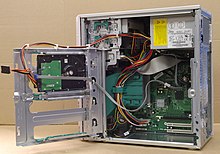BTX format
|
Housing formats |
|---|
The BTX format ("Balanced Technology Extended") was planned as the successor to the ATX format as a form factor for PCs. The new standard was first presented in 2003 at the Intel Developer Forum , but could not prevail over the established ATX format due to a lack of acceptance and was withdrawn from the market by Intel in October 2006 . Similar to the ATX format, there are additional form factors for smaller housings, one MicroBTX and the even smaller PicoBTX format.
technology


The BTX housing is divided into zones in which only certain components, such as the main processor , are allowed.
- The mainboard - seen from the front - is installed on the left instead of the right side in the case, i.e. mirrored.
- The processor cooler is not attached to the mainboard, but screwed directly to the case. As a result, it can be significantly heavier and higher than the ATX without running the risk of damaging the mainboard or CPU. This risk is greatest when transporting finished PCs.
- A large fan is essential for the processor cooler, which transports air from the front to the back. The processor cooler is to be dimensioned in such a way that its air flow also cools all chips that are passively cooled. These are to be attached in the air flow.
- The RAM sockets must be positioned parallel to this air flow. With most ATX boards, they are perpendicular to the expansion slots and just to such an air flow.
- The graphics card is in the airflow of this main cooler; In the case of ATX, this can (but does not have to) be in a standing air cushion.
- In addition, the installation on the left ensures that the graphics chip is now on the top of the graphics card, so that no heat build-up occurs as warm air can rise immediately.
- If the graphics card is actively cooled, the cooler no longer has to be squeezed between the graphics card and the next expansion card, but looks in the other direction. Enough air can be sucked in from there.
- PCI-Express (x16) as the standard slot for graphics cards.
- PCI-Express (x1), (x4) or (x8) are also available, depending on the motherboard, as well as conventional PCI slots
- The four-pole 12 V plug for a more stable power supply to the processor is mandatory.
advantages
- Sufficiently good cooling is easy to achieve
- A sufficiently good cooling can be implemented more quietly
- The acceleration forces exerted by the processor cooler are absorbed by the SRM ( Standard Support and Retention Module ) and thus by the housing;
disadvantage
- By inserting the PCI and PCI-Express cards in the motherboard upside down, the side equipped with capacitors, chips and other electronic components is on top, which quickly leads to dust; the dust is difficult to remove on this side of the cards (e.g. with compressed air sprays). With ATX cases, the smooth, unpopulated side of the cards faces up - the dust that collects there can be easily wiped off.
Dimensions
- BTX: 325.12 mm × 266.70 mm
- microBTX: 264.16 mm × 266.70 mm
- nanoBTX: 223.52 mm × 266.70 mm
- picoBTX: 203.20 mm x 266.70 mm
distribution
BTX hardware, d. H. Housing and mainboard, was mainly to be found on the market in the form of finished PCs, especially for business customers. As presumably the last motherboards based on Intel processors were boards from Fujitsu with Socket 775 and Socket 1156 in BTX format, which among other things supported "PCIe x16" and DDR3 RAM.
Web links
- BTX specification at formfactors.org
- WinFuture: Intel wants to make the BTX housing standard more popular , Michael Diestelberg, July 12, 2006 ; Retrieved December 7, 2016 .
swell
- ↑ Fujitsu: CELSIUS W480 WorkStation (English), as of September 16, 2011
- ↑ Fujitsu: P5731 desktop PC. (English), as of July 21, 2011